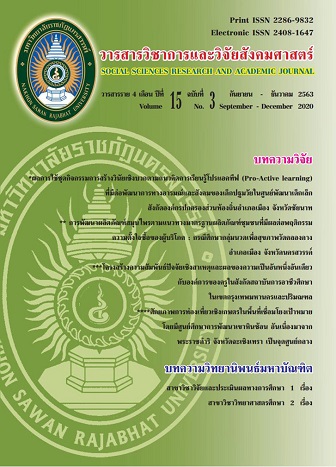โครงสร้างความสัมพันธ์ปัจจัยเชิงสาเหตุและผลของความเป็นอันหนึ่งอันเดียวกับองค์การของครูในสังกัดสถาบันการอาชีวศึกษาในเขตกรุงเทพมหานครและปริมณฑล Structural Relationships of the Antecedents and Effects of Organizational Identification of Teachers in Institute of Vocational Education in Bangkok and Perimeter
Main Article Content
Abstract
การวิจัยนี้มีวัตถุประสงค์เพื่อศึกษาโครงสร้างความสัมพันธ์ปัจจัยเชิงสาเหตุและผลของความเป็นอันหนึ่งอันเดียวกับองค์การของครูในสังกัดสถาบันการอาชีวศึกษาในเขตกรุงเทพมหานครและปริมณฑล ตัวอย่างในการวิจัยเป็นครูในสังกัดสถาบันการอาชีวศึกษาในเขตกรุงเทพมหานครและปริมณฑล จำนวน 544 คน ที่ได้จากการสุ่มตัวอย่างแบบหลายขั้นตอน เก็บข้อมูลโดยใช้แบบวัด 7 ฉบับ มีค่าความเชื่อมั่นแบบสอดคล้องภายในอยู่ตั้งแต่ 0.845-0.953 ในการวิเคราะห์ข้อมูลใช้สถิติเชิงบรรยาย การวิเคราะห์ความเที่ยงตรงเชิงโครงสร้างโดยการวิเคราะห์องค์ประกอบเชิงยืนยัน และการวิเคราะห์โครงสร้างความสัมพันธ์ปัจจัยเชิงสาเหตุ
ผลการวิจัยสรุปได้ว่า โครงสร้างความสัมพันธ์ปัจจัยเชิงสาเหตุและผลของความเป็นอันหนึ่งอันเดียวกับองค์การของครูในสังกัดสถาบันการอาชีวศึกษาในเขตกรุงเทพมหานครและปริมณฑลมีความกลมกลืนกับข้อมูลเชิงประจักษ์หลังจากการปรับโมเดลในระดับที่ยอมรับได้ (X2= 599.74, df= 152; p-value< 0.01, SRMR= 0.042, RMSEA= 0.070, GFI= 0.91, NFI= 0.97, CFI= 0.98, NNFI= 0.97, PNFI= 0.78) ผลการทดสอบเส้นอิทธิพลพบว่า ความเป็นอันหนึ่งอันเดียวกับองค์การได้รับอิทธิพลทางบวกโดยตรงจากภาวะผู้นำเชิงจริยธรรม และการรับรู้ชื่อเสียงจากภายนอก ซึ่งตัวแปรเหล่านี้ร่วมกันอธิบายความเป็นอันหนึ่งอันเดียวกับองค์การได้ร้อยละ 43 ตัวแปรพฤติกรรมการทำงานอย่างมีจริยธรรมได้รับอิทธิพลทางบวกโดยตรงจากความเป็นอันหนึ่งอันเดียวกับองค์การและภาวะผู้นำเชิงจริยธรรม รวมทั้งได้รับอิทธิพลทางบวกโดยอ้อมจากภาวะผู้นำเชิงจริยธรรม และการรับรู้ชื่อเสียงจากภายนอก ซึ่งตัวแปรเหล่านี้ร่วมกันอธิบายความยึดมั่นผูกพันในการทำงานได้ร้อยละ 42 ตัวแปรพฤติกรรมการเป็นสมาชิกที่ดีขององค์การได้รับอิทธิพลทางบวกโดยตรงจากความเป็นอันหนึ่งอันเดียวกับองค์การและการรับรู้ชื่อเสียงจากภายนอก รวมทั้งได้รับอิทธิพลทางบวกโดยอ้อมจากจากภาวะผู้นำเชิงจริยธรรม และการรับรู้ชื่อเสียงจากภายนอก ซึ่งตัวแปรเหล่านี้ร่วมกันอธิบายพฤติกรรมการเป็นสมาชิกที่ดีขององค์การได้ร้อยละ 52 ส่วนตัวแปรความตั้งใจออกจากวิชาชีพได้รับอิทธิพลทางลบโดยตรงจากความเป็นอันหนึ่งอันเดียวกับองค์การ รวมทั้งได้รับอิทธิพลทางลบโดยอ้อมจากจากภาวะผู้นำเชิงจริยธรรม และการรับรู้ชื่อเสียงจากภายนอก ซึ่งตัวแปรเหล่านี้ร่วมกันอธิบายความตั้งใจออกจากวิชาชีพได้ร้อยละ 6
The purpose of this study was to examine the structural relationships of the antecedents and effects of organizational identification of teachers in institute of vocational education in bangkok and perimeter. The samples were selected by multi-stage sampling. The population consisted of teachers in institute of vocational education in bangkok and perimeter. The total sample in this study was consisted of five hundred and forty four individuals. There were seven tests the questionnaire with an internal consistency reliability of 0.845-0.953. The descriptive statistics were analyzed by SPSS for Windows while confirmatory factor analysis and structural relationship were analyzed by LISREL.
The research findings were as follows: The hypothesized structural relationships of the antecedents and effects of organizational identification of teachers in institute of vocational education in bangkok and perimeter was adjusted in harmony with the fitted empirical data (X2 = 599.74, df= 152; p-value< 0.01, SRMR= 0.042, RMSEA= 0.070, GFI= 0.91, NFI= 0.97, CFI= 0.98, NNFI= 0.97, PNFI= 0.78). In terms of organizational identification, the variables that had direct positive effects: ethical leadership and perceived external prestige. These variables accounted for forty three percent of the variance of the aspect of organizational identification. For the factor of ethical work behavior, the variables which had direct positive effects was organizational identification and ethical leadership. In addition, the variables which had indirect positive effects were: ethical leadership and perceived external prestige. These variables accounted for forty two percent of the variance in terms of ethical work behavior. For the factor of organizational citizenship behavior, the variables which had direct positive effects were: organizational identification and perceived external prestige. In addition, the variables which had indirect positive effects were: ethical leadership and perceived external prestige. These variables accounted for fifty two percent of the variance of organizational citizenship behavior. With regard to intention to leave teaching profession, the variables which had direct negative effects was organizational identification. In addition, the variables which had indirect negative effects were: ethical leadership and perceived external prestige. These variables accounted for six percent of the variance of intention to leave teaching profession.
Article Details
References
คุรุสภา. (2556). ข้อบังคับคุรุสภา ว่าด้วยจรรยาบรรรณของวิชาชีพ พ.ศ. 2556. สืบค้นเมื่อ 20 พฤษภาคม 2562, จาก http://www.ksp.or.th/ksp2018/wp-content/uploads/2018/11/ข้อบังคับคุรุสภา-ว่าด้วยจรรยาบรรรณของวิชาชีพ.pdf
คุรุสภา. (2556). ข้อบังคับคุรุสภา ว่าด้วยมาตรฐานวิชาชีพ พ.ศ. 2556. สืบค้นเมื่อ 20 พฤษภาคม 2562, จาก http://www.educ.su.ac.th/images/curriculum/ข้อบังคับคุรุสภา-ว่าด้วยมาตรฐานวิชาชีพ.pdf
ปิยรัฐ ธรรมพิทักษ์. (2558). โครงสร้างความสัมพันธ์เชิงสาเหตุพหุระดับของตัวแปรเชิงเหตุและภาวะผู้นำเชิงจริยธรรมของผู้บริหารที่มีผลต่อจิตลักษณะและพฤติกรรมที่เกี่ยวกับการทำงานของพนักงานในองค์การเอกชน. ปริญญานิพนธ์ วท.ด. (การวิจัยพฤติกรรมศาสตร์ประยุกต์). มหาวิทยาลัยศรีนครินทรวิโรฒ, กรุงเทพฯ.
ภัณฑิลา นุ่มสังข์ และสุทธินันทน์ พรหมสุวรรณ. (2558). วัฒนธรรมองค์กรและทัศนคติและบรรยากาศในการทำงานที่มีผลต่อประสิทธิผลในการปฏิบัติงานของพนักงานระดับปฏิบัติการ กรณีศึกษาพนักงานระดับปฏิบัติการพนักงานบริษัทในพื้นที่ย่านถนนเพลินจิต และถนนสุขุมวิท. สืบค้นเมื่อ 10 พฤษภาคม 2563, จาก http://dspace.bu.ac.th/itstream/123456789/1400/1/j_pantila.nums.pdf
วิสุทธิ์ สีนวล และเพ็ญนภา ทองคำ. (2560). รายงานการวิจัย เรื่อง โครงสร้างความสัมพันธ์ปัจจัยเชิงสาเหตุของความเป็นอันหนึ่งอันเดียวกับองค์การที่ส่งผลต่อความยึดมั่นผูกพันในการทำงาน และพฤติกรรมการเป็นสมาชิกที่ดีขององค์การของพนักงานโรงงานอุตสาหกรรมอิเล็คทรอนิคส์ในเขตจังหวัดปทุมธานี. ปทุมธานี: คณะศิลปศาสตร์ มหาวิทยาลัยเทคโนโลยีราชมงคลธัญบุรี. ถ่ายเอกสาร.
ศิลป์ ชื่นนิรันดร์. (2560). การเสริมสร้างคุณธรรมและจริยธรรมในองค์กร (Morality and Ethical Reinforcement in Public Organization). วารสารมหาวิทยาลัยมหามกุฏราชวิทยาลัย วิทยาเขตร้อยเอ็ด, 6(2), 216-225.
สมหญิง ลมูลพักตร์. (2558). ปัจจัยเชิงเหตุพหุระดับและผลของความยึดมั่นผูกพันในวิชาชีพการพยาบาลที่ส่งผลต่อผลการปฏิบัติงาน และความตั้งใจออกจากวิชาชีพของพยาบาลวิชาชีพโรงพยาบาลรัฐ กรุงเทพมหานคร. ปริญญานิพนธ์ วท.ด. (การวิจัยพฤติกรรมศาสตร์ประยุกต์). มหาวิทยาลัยศรีนครินทรวิโรฒ, กรุงเทพฯ.
Ahmad, I., Gao, Y., & Hali, S. M. (2017). Impact of Ethical Leadership on Follower’s In-role Performance: Evidence from Pakistan. European Journal of Business and Management, 9(27), 174-185.
Aiken, L. R. (2003). Psychological Testing and Assessment. 11th ed. Boston: Allyn and Bacon.
Aleassa, H. M., & Zurigat, Z. M. (2014). Organizational Identification, Corporate Ethical Values, and Intention to Report Peers' Unethical Behavior. European Journal of Business and Management, 6(15), 76-85.
Ashforth, B. E., & Mael, F. (1989). Social Identity Theory and the Organization. The Academy of Management Review, 14(1), 20-39.
Basar, U., & Sigri, U. (2015). Effects of Teachers’ Organizational Justice Perceptions on Intention to Quit: Mediation Role of Organizational Identification. Educational Sciences: Theory & Practice. 15(1), 45-59.
Colquitt, J. A. (2001). On the Dimensionality of Organizational Justice: A Construct Validation of a Measure. Journal of Applied Psychology, 86(3), 386-400.
Hair, J. F., Jr., Black, W. C., Babin, B. J., & Anderson, R. E. (2010). Multivariate Data Analysis: A Global Perspective. 7th ed. New Jersey: Prentice Hall.
Hasan, M., & Hussain, M. (2015). Role of Perceived External Prestige and Organizational Justice in Organizational Identification. European Online Journal of Natural and Social Sciences, 4(3), 611-625.
Johnson, M. D., & Morgeson, F. P. (2005). Cognitive and Affective Identification in Organizational Settings. Best Paper Proceeding, 65th Annual Meeting of the Academy of Management. Honolulu, HI.
Jones, C., & Volpe, E. H. (2010). Organizational identification: Extending our understanding of social identities through social networks. Journal of Organizational Behavior. Published online in Wiley InterScience: 1-22.
Kim, M. Y., Miao, Q., & Park, S. M. (2015). Exploring the Relationship between Ethical Climate and Behavioral Outcomes in the Chinese Public Sector: The Mediating Roles of Affective and Cognitive Responses. International Journal of Business, Humanities and Technology, 5(3), 88-103.
Kose, T., & Kose, S. D. (2016). The Effect of Ethical Leadership on Perceived Organizational Identification: The Mediating Role of Ethical Climate. The International Journal of Business & Management, 4(1), 368-374.
Podsakoff, P. M., Moorman, R. H., & Fetter, R. (1990).Transformation Leader Behaviors and their Effect on Followers' Trust in Leader, Satisfaction, and Organizational Citizenship Behavior. Leader Quarterly, 1, 107-142.
Schumacker, R. E., & Lomax, R. G. (2004). A Beginner's Guide to Structural Equation Modeling. 2nd ed. New Jersey: Lawrence Erlbaum Associates.
Smith, C. A., Organ, D. W.; & Near, J. P. (1983). Organizational Citizenship Behavior: It's Nature and Antecedents. Journal of Applied Psychology, 68(4), 653-663.
Smith, C. L. (2012). The Perception of Organizational Prestige and Employee Engagement. Thesis, MS. (Psychology). Fort Collins: Colorado State University. Photocopied.
Terzi, A. R., et al. (2017). An Analysis of Organizational Justice and Organizational Identification Relation Based on Teachers' Perceptions. Universal Journal of Educational Research, 5(3), 488-495.
Wacker, O. (2017). Linking ethical Leadership to Employee Well-Being: The Role of Organizational Identification and Moral Uncertainty. Master Thesis, MSc. (Psychology). Faculty of Psychology and Neuroscience. Maastricht University. Photocopied.


